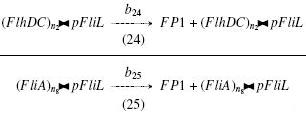Team:Paris/Modeling/Molecular Reactions
From 2008.igem.org
(Difference between revisions)
| Line 2: | Line 2: | ||
{{Paris/Header|Molecular Reactions}} | {{Paris/Header|Molecular Reactions}} | ||
| - | We show here the elementary reactions from wich we started. They intend to be "exhaustives" in the sense that every steps of the <span style="color:# | + | We show here the elementary reactions from wich we started. They intend to be "exhaustives" in the sense that every steps of the <span style="color:#0000FF;">system</span> is described. Each of those reactions has to be "mathematically interpreted", in a <span style="color:#0000FF;">model</span> that accounts for the important phenomenon, and in the same time allows us to find <span style="color:#0000FF;">experimentally</span> every involved parameters. |
| - | {{Paris/Toggle| | + | {{Paris/Toggle|details on <span style="color:#0000FF;">terms</span>|Team:Paris/Modeling/More_Mol_Reac_Intro}} |
<br> | <br> | ||
| - | '''The system we are studying is the <span style="color:# | + | '''The system we are studying is the <span style="color:#0000FF;">"Core System"</span> ''' that we can represent in the <span style="color:#0000FF;">scheme</span> just below (with all alternatives ''pFlhDC'' or ''pTet'' and ''TetR'' or ''envZ'' or ''OmpR<sup>*</sup>'') |
| - | {{Paris/Toggle| | + | {{Paris/Toggle|details on <span style="color:#0000FF;">terms</span>|Team:Paris/Modeling/More_Mol_Reac_System}} |
<br> | <br> | ||
Revision as of 00:01, 27 October 2008
|
Molecular Reactions
We show here the elementary reactions from wich we started. They intend to be "exhaustives" in the sense that every steps of the system is described. Each of those reactions has to be "mathematically interpreted", in a model that accounts for the important phenomenon, and in the same time allows us to find experimentally every involved parameters. ↓ Team:Paris/Modeling/More_Mol_Reac_Intro ↑
The system we are studying is the "Core System" that we can represent in the scheme just below (with all alternatives pFlhDC or pTet and TetR or envZ or OmpR*) ↓ Team:Paris/Modeling/More_Mol_Reac_System ↑
for complete .pdf with all reactions and references : [list of reactions/equations]
|
 "
"




